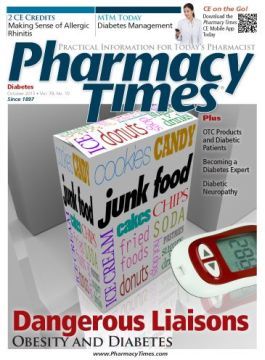Publication
Article
Pharmacy Times
Type 2 Diabetes
Author(s):
Offering brown bag sessions to diabetes patients can help you monitor compliance in a patient dealing with a complex disease state as well as a number of other benefits.

Nearly 1 in 10 people in the United States is estimated to have diabetes mellitus (DM). In the community pharmacy setting, we dispense drugs to treat DM and its symptoms on a daily basis. The pharmacy team plays a large role in proper DM education and care. Lowering glucose and glycated hemoglobin (A1C) levels are important goals for any patient with DM. It is known that an A1C within guidelines can help prevent microvascular complications of DM, which may include nephropathy, retinopathy, and neuropathy. Reaching blood pressure and lipid goals are also important. The community pharmacy can help serve not only as a resource but also as a “hub” for accessible clinical services and DM care.
Offering brown bag sessions to patients with DM can be of great help. Not only can it help you monitor compliance in a patient dealing with a complex disease state, it also helps you check for the appropriateness of drug therapy, cost-saving opportunities, and therapy duplications or interactions.
Meet Your Patient...Again
JL is a 67-year-old female who frequents your pharmacy. You know from previous conversations and brown bag sessions that JL is a retired school administrator and does not have a very active lifestyle. JL has come in to pick up her monthly refills. You noticed a few months ago that she was having trouble with adherence and, after much work and an initial brown bag session, you were finally able to get all 7 of her prescription medications refilled at the same time. JL is very happy about this, uses only your pharmacy now, and hopes this will help her better manage her various conditions. JL is very forgetful and often needs to be asked questions during a counseling session.
You notice JL is scanning blood glucose meters, which prompts you to ask her about her daily DM regimen. You explain the benefits of a healthy lifestyle—incorporating diet and exercise—and tell JL that using a meter is necessary for proper blood sugar control. JL says she is afraid of needles and asks you to recommend a new meter and help her get comfortable using it. You suggest another brown bag session and explain that you would like to review her medications for accuracy in addition to teaching her about the new meter and strips. You ask her to come back to the pharmacy tomorrow with all of her medications and the meter so you can provide some education and address her concerns. JL appreciates your willingness to help. Tomorrow’s overlap pharmacist coverage will allow you to focus your attention on JL.
JL arrives the next day with the following medications and devices in her brown bag:
- OneTouch UltraMini (LifeScan, Inc) meter and test strips
- OTC aspirin EC 81 mg once daily
- Metformin 500 mg twice daily
- Pioglitazone 45 mg once daily
- Atorvastatin 80 mg once daily
- Enalapril 5 mg once daily
- Furosemide 40 mg once daily
- Levothyroxine 25 mcg once every morning
- Lorazepam 1 mg as needed for anxiety
- Sertraline 50 mg daily
- Prednisone 10 mg as directed, scribed by urgent care center
- OTC multivitamin once daily
Without having lab values or a medical chart at your disposal during a brown bag session, you review JL’s medications and make some initial suggestions. JL qualifies for a medication therapy management (MTM) session, so you offer her one in order to extensively counsel her on her medications and disease states. JL says that she is interested, will follow up with you on her blood sugar testing technique, and will call you with her glucose numbers and last A1C. From your professional relationship with her health care providers, you know JL is very compliant with lab work and keeping her appointments. After reviewing the new blood glucose meter with JL and helping her get comfortable testing her blood sugar, you suggest the following:
- Depending on JL’s pre- and post-meal blood sugar numbers and her A1C, you offer to follow up with her provider on whether the metformin and pioglitazone are her best options. Based on JL’s refill history, you have noticed that the metformin dosing has fluctuated. She agrees to keep you updated so you can help her and reduce any confusion.
- You perform 3/3 blood pressure checks and notice JL’s blood pressure is elevated. You will follow up with the prescriber on JL’s enalapril and furosemide doses and check whether the provider still deems this appropriate therapy. JL admits she uses more of her “anxiety meds” when she “feels” her blood pressure rising.
- JL admits that she has gained some weight over the past year and has not had her thyroid levels checked as often as she should. You recommend that she have her thyroid checked to determine the appropriate levothyroxine dose, as her thyroid levels may have contributed to the weight gain.
- JL’s atorvastatin prescription was recently increased, and she admits to some slight muscle discomfort. You recommend follow-up with her cardiologist for lab testing to ensure the appropriateness of the dose.
What other suggestions do you have for JL? How can you encourage her to participate in an MTM session?
Dr. Drury works as a clinical pharmacy specialist in Chicago, Illinois, and Milwaukee, Wisconsin. She earned her doctor of pharmacy from Midwestern University College of Pharmacy. Her blog, Compounding in the Kitchen, appears on www.PharmacyTimes.com.







